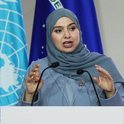Click here to read areplyfrom Roger Bate of Africa Fighting Malaria
Rachel Carson launched the modern environmental movement. She was posthumously awarded the US presidential medal of freedom, and has conservation areas, prizes and associations named in her honour.
Yet Carson has also been accused of killing more people than Hitler. Her detractors hold her responsible for a "ban" on the use of the insecticide DDT (Dichlorodiphenyltrichloroethane), which, they claim, halted a campaign that was on the verge of eradicating malaria in the 1960s.
Some mainstream journalists have accepted this story, which in turn has led to pressure on the World Health Organisation (WHO) and other bodies to change policies and personnel. Yet perhaps the most striking feature of the claim against Carson is the ease with which it can be refuted. It takes only a few minutes with Google to discover that DDT has never been banned for anti-malarial uses, and that it is in use in at least 11 countries.
It takes only a little more time to discover that the postwar attempt to eradicate malaria by the spraying of DDT was a failure, largely because Carson's warnings that overuse of insecticides would lead to the development of resistance in mosquito populations were ignored. Modern uses of insecticides are far closer to the methods advocated by Carson than to the practices she criticised.
How, then, did the idea that Carson was responsible for millions of deaths gain currency? Any good myth requires a few grains of truth, and the DDT malaria story has a couple. First, the 2001 Stockholm convention on persistent organic pollutants prohibits the use of DDT except for disease control, and calls for all DDT use to be phased out. The phase-out commitment is often loosely referred to as a "ban."
Second, by virtue of its massive misuse in the 1960s and 1970s, DDT gained a bad reputation that was hard to shake. As a result, says WHO's Allan Schapira, donors have sometimes insisted on the use of an insecticide other than DDT, even in "countries where the government wished to use DDT, and there was evidence that it was the best option for malaria-vector control."
But these grains of truth are scarcely enough to generate a myth as widespread as that of "Rachel Carson, baby killer." So what accounts for the campaign against Carson? The story begins in the 1940s. Swiss chemist Paul Hermann Müller won the 1948 Nobel prize for medicine for his discovery of the efficacy of DDT against several arthropods. It was used in the war by Allied forces with striking success to protect troops and civilians from the insects that transmit malaria, typhus and other diseases.
After the war, the use of DDT continued apace. In 1955, the WHO adopted a global malaria eradication campaign, based on spraying DDT on to the interior walls of houses to protect residents against malaria-carrying mosquitoes. The insecticide was well suited for this task because it was "persistent," meaning that a wall sprayed with DDT would kill mosquitoes that rested on it for six months after spraying.
The programme was never extended to sub-Saharan Africa, where malaria was most acute. But the failure of the programme was not the result of underuse: quite the opposite. In the first flush of enthusiasm for DDT in the 1950s, the range of applications was rapidly extended from disease control to agricultural and other uses. DDT was widely used in both developed and less developed countries to protect crops against pests. Indiscriminate use in agriculture led to the evolution of DDT-resistant mosquitoes.
Rachel Carson, a prominent American science writer, had long been concerned about the impact of DDT and other pesticides on the environment. In 1962, her ideas were crystallised in the bestseller Silent Spring, which made the case that overuse of pesticides was a threat to wildlife, human health and even their own usefulness against malaria. Within a year, the US president's science advisory committee called for a reduction in the use of persistent pesticides. In 1972, the use of DDT in US agriculture was banned, though an exception (which has never been used) was made for emergency public health applications.
Meanwhile, the DDT-based eradication campaign against malaria ran into the trouble Carson had warned about. The high-water mark of the campaign came in 1964. Sri Lanka had reduced its number of malaria cases from millions after the end of the war to just 29. The country declared victory over malaria and suspended spraying. WHO called the eradication programme "an international achievement without parallel in the provision of public health service."
But then malaria returned to Sri Lanka. In 1968-69, there were half a million cases. The country went back to spraying DDT, but because it had been extensively used in agriculture, mosquitoes had evolved resistance. The insecticide became less and less effective, eventually forcing Sri Lanka to switch to an alternative, malathion, in the mid-1970s. Other countries in the eradication program suffered similar setbacks, and by 1969, the 22nd World Health Assembly concluded that the goal of global eradication of malaria was not feasible.
By 1990, it seemed that the public health issues surrounding DDT had been largely resolved. In developed countries, DDT had been replaced by less environmentally damaging alternatives. But soon the situation changed radically. The tobacco industry, faced with the prospect of bans on smoking in public places, sought to cast doubt on the science behind the mooted ban. But a campaign focused on tobacco alone was doomed to failure. So the industry tried a different tack, an across-the-board attack on what it called "junk science." Its primary vehicle was the Advancement of Sound Science Coalition (TASSC), a body set up by PR firm APCO in the early 1990s and secretly funded by Philip Morris.
TASSC, led by an activist named Steve Milloy, attacked the environmental movement on everything from food safety to the risks of asbestos. One of the issues Milloy took up with vigour was DDT, where he teamed up with the entomologist J Gordon Edwards. With the aid of Milloy's advocacy, Edwards's attacks on Rachel Carson moved from the political fringes to become part of the orthodoxy of mainstream US Republicanism.
Tobacco companies created a European version of TASSC, the European Science and Environment Forum (ESEF), led by Roger Bate, another tobacco lobbyist. In the late 1990s, Bate established "Africa Fighting Malaria," a so-called "astroturf" organisation based in Washington DC. His aim was to drive a wedge between public health and the environment by suggesting that by banning DDT to protect birds, environmentalists were causing many people to die from malaria. Between them, Milloy's TASSC and Bate's Africa Fighting Malaria convinced many that DDT was a panacea for malaria, denied to the third world by the machinations of rich environmentalists.
For both groups, the big opportunity came with the 2001 Stockholm convention. The treaty banned most uses of organochlorine pesticides such as DDT and dieldrin because of their persistence and toxicity. It was agreed that the use of DDT for malaria control should be exempted from the general ban until affordable substitutes could be found. The only point of dispute was whether an explicit target date for the phase-out of DDT should be set.
The pro-DDT brigade pounced on the phase-out proposal, describing it as a "ban," and news stories made it appear that the ban was imminent. Yet during the negotiations, the World Wide Fund for Nature, the main supporters of a targeted phase-out date, abandoned its proposal, focusing instead on more stringent attempts to control the illegal use of DDT in agriculture. The outcome was an eminently sensible one.
But the debate had given Milloy, Bate and others the start they needed. Successfully conflating the use of the term "ban" to describe the eventual phase-out proposal with the 1972 ban on agricultural use in the US, Milloy produced his "malaria clock," which blamed the "ban" for all malaria deaths since 1972. Meanwhile, Bate and Africa Fighting Malaria continued to claim that the widespread use of DDT was being prevented solely because of the opposition of western environmentalists.
The high point of the pro-DDT campaign came in late 2006, with the appointment of Arata Kochi as head of the WHO malaria program. Kochi saw the need to placate the critics associated with the Bush administration, and issued an announcement describing a renewed commitment to DDT. The "new" position was little more than a restatement of long-standing policy. Nevertheless, it appeased critics and mobilised support for additional funds, particularly from the US government.
Kochi's announcement was hailed as a triumph by the promoters of the DDT myth. But the environmentalists and scientists started fighting back. The idea of DDT spraying as a panacea for malaria threatened, they said, to derail the tentative progress that was being made with campaigns incorporating improved treatments, insecticide-treated bed nets and a range of public health measures.
The response of the pro-DDT campaigners was revealing. Milloy, who has long shown himself to be utterly shameless, maintained his malaria clock, adding footnotes to indicate that he knew his claims to be false. By contrast, Bate began to adjust his position, noting in a recent interview that, "I think my position has mellowed, perhaps with age."
Sanity now appears to be returning to the malaria debate. At meetings on the implementation of the Stockholm convention, WHO put out another restatement of its position, this time stressing the commitment to an eventual phase-out of DDT, while noting that its use would continue until adequate substitutes were found.
In 2007, the WHO concluded that long-lasting insecticide treated bed nets were more cost-effective than DDT spraying in high malaria transmission areas. Earlier this year, it announced dramatic progress against malaria in Rwanda and Ethiopia based on a strategy of long-lasting insecticidal nets and artemisinin-combination therapy drugs.
Following these successes, the goal of global eradication of malaria has been revived. The hope is that a combination of existing measures, like bed nets, insecticides (including DDT among others) and drugs, can drive down the number of cases and shrink malaria's range across Africa and Asia. The new strategy is based on a judicious mix of tactics against malaria, rather than a knockout blow based on a single weapon. Rachel Carson would surely have approved.
Click here to read areplyfrom Roger Bate of Africa Fighting Malaria
Rachel Carson launched the modern environmental movement. She was posthumously awarded the US presidential medal of freedom, and has conservation areas, prizes and associations named in her honour.
Yet Carson has also been accused of killing more people than Hitler. Her detractors hold her responsible for a "ban" on the use of the insecticide DDT (Dichlorodiphenyltrichloroethane), which, they claim, halted a campaign that was on the verge of eradicating malaria in the 1960s.
Some mainstream journalists have accepted this story, which in turn has led to pressure on the World Health Organisation (WHO) and other bodies to change policies and personnel. Yet perhaps the most striking feature of the claim against Carson is the ease with which it can be refuted. It takes only a few minutes with Google to discover that DDT has never been banned for anti-malarial uses, and that it is in use in at least 11 countries.
It takes only a little more time to discover that the postwar attempt to eradicate malaria by the spraying of DDT was a failure, largely because Carson's warnings that overuse of insecticides would lead to the development of resistance in mosquito populations were ignored. Modern uses of insecticides are far closer to the methods advocated by Carson than to the practices she criticised.
How, then, did the idea that Carson was responsible for millions of deaths gain currency? Any good myth requires a few grains of truth, and the DDT malaria story has a couple. First, the 2001 Stockholm convention on persistent organic pollutants prohibits the use of DDT except for disease control, and calls for all DDT use to be phased out. The phase-out commitment is often loosely referred to as a "ban."
Second, by virtue of its massive misuse in the 1960s and 1970s, DDT gained a bad reputation that was hard to shake. As a result, says WHO's Allan Schapira, donors have sometimes insisted on the use of an insecticide other than DDT, even in "countries where the government wished to use DDT, and there was evidence that it was the best option for malaria-vector control."
But these grains of truth are scarcely enough to generate a myth as widespread as that of "Rachel Carson, baby killer." So what accounts for the campaign against Carson? The story begins in the 1940s. Swiss chemist Paul Hermann Müller won the 1948 Nobel prize for medicine for his discovery of the efficacy of DDT against several arthropods. It was used in the war by Allied forces with striking success to protect troops and civilians from the insects that transmit malaria, typhus and other diseases.
After the war, the use of DDT continued apace. In 1955, the WHO adopted a global malaria eradication campaign, based on spraying DDT on to the interior walls of houses to protect residents against malaria-carrying mosquitoes. The insecticide was well suited for this task because it was "persistent," meaning that a wall sprayed with DDT would kill mosquitoes that rested on it for six months after spraying.
The programme was never extended to sub-Saharan Africa, where malaria was most acute. But the failure of the programme was not the result of underuse: quite the opposite. In the first flush of enthusiasm for DDT in the 1950s, the range of applications was rapidly extended from disease control to agricultural and other uses. DDT was widely used in both developed and less developed countries to protect crops against pests. Indiscriminate use in agriculture led to the evolution of DDT-resistant mosquitoes.
Rachel Carson, a prominent American science writer, had long been concerned about the impact of DDT and other pesticides on the environment. In 1962, her ideas were crystallised in the bestseller Silent Spring, which made the case that overuse of pesticides was a threat to wildlife, human health and even their own usefulness against malaria. Within a year, the US president's science advisory committee called for a reduction in the use of persistent pesticides. In 1972, the use of DDT in US agriculture was banned, though an exception (which has never been used) was made for emergency public health applications.
Meanwhile, the DDT-based eradication campaign against malaria ran into the trouble Carson had warned about. The high-water mark of the campaign came in 1964. Sri Lanka had reduced its number of malaria cases from millions after the end of the war to just 29. The country declared victory over malaria and suspended spraying. WHO called the eradication programme "an international achievement without parallel in the provision of public health service."
But then malaria returned to Sri Lanka. In 1968-69, there were half a million cases. The country went back to spraying DDT, but because it had been extensively used in agriculture, mosquitoes had evolved resistance. The insecticide became less and less effective, eventually forcing Sri Lanka to switch to an alternative, malathion, in the mid-1970s. Other countries in the eradication program suffered similar setbacks, and by 1969, the 22nd World Health Assembly concluded that the goal of global eradication of malaria was not feasible.
By 1990, it seemed that the public health issues surrounding DDT had been largely resolved. In developed countries, DDT had been replaced by less environmentally damaging alternatives. But soon the situation changed radically. The tobacco industry, faced with the prospect of bans on smoking in public places, sought to cast doubt on the science behind the mooted ban. But a campaign focused on tobacco alone was doomed to failure. So the industry tried a different tack, an across-the-board attack on what it called "junk science." Its primary vehicle was the Advancement of Sound Science Coalition (TASSC), a body set up by PR firm APCO in the early 1990s and secretly funded by Philip Morris.
TASSC, led by an activist named Steve Milloy, attacked the environmental movement on everything from food safety to the risks of asbestos. One of the issues Milloy took up with vigour was DDT, where he teamed up with the entomologist J Gordon Edwards. With the aid of Milloy's advocacy, Edwards's attacks on Rachel Carson moved from the political fringes to become part of the orthodoxy of mainstream US Republicanism.
Tobacco companies created a European version of TASSC, the European Science and Environment Forum (ESEF), led by Roger Bate, another tobacco lobbyist. In the late 1990s, Bate established "Africa Fighting Malaria," a so-called "astroturf" organisation based in Washington DC. His aim was to drive a wedge between public health and the environment by suggesting that by banning DDT to protect birds, environmentalists were causing many people to die from malaria. Between them, Milloy's TASSC and Bate's Africa Fighting Malaria convinced many that DDT was a panacea for malaria, denied to the third world by the machinations of rich environmentalists.
For both groups, the big opportunity came with the 2001 Stockholm convention. The treaty banned most uses of organochlorine pesticides such as DDT and dieldrin because of their persistence and toxicity. It was agreed that the use of DDT for malaria control should be exempted from the general ban until affordable substitutes could be found. The only point of dispute was whether an explicit target date for the phase-out of DDT should be set.
The pro-DDT brigade pounced on the phase-out proposal, describing it as a "ban," and news stories made it appear that the ban was imminent. Yet during the negotiations, the World Wide Fund for Nature, the main supporters of a targeted phase-out date, abandoned its proposal, focusing instead on more stringent attempts to control the illegal use of DDT in agriculture. The outcome was an eminently sensible one.
But the debate had given Milloy, Bate and others the start they needed. Successfully conflating the use of the term "ban" to describe the eventual phase-out proposal with the 1972 ban on agricultural use in the US, Milloy produced his "malaria clock," which blamed the "ban" for all malaria deaths since 1972. Meanwhile, Bate and Africa Fighting Malaria continued to claim that the widespread use of DDT was being prevented solely because of the opposition of western environmentalists.
The high point of the pro-DDT campaign came in late 2006, with the appointment of Arata Kochi as head of the WHO malaria program. Kochi saw the need to placate the critics associated with the Bush administration, and issued an announcement describing a renewed commitment to DDT. The "new" position was little more than a restatement of long-standing policy. Nevertheless, it appeased critics and mobilised support for additional funds, particularly from the US government.
Kochi's announcement was hailed as a triumph by the promoters of the DDT myth. But the environmentalists and scientists started fighting back. The idea of DDT spraying as a panacea for malaria threatened, they said, to derail the tentative progress that was being made with campaigns incorporating improved treatments, insecticide-treated bed nets and a range of public health measures.
The response of the pro-DDT campaigners was revealing. Milloy, who has long shown himself to be utterly shameless, maintained his malaria clock, adding footnotes to indicate that he knew his claims to be false. By contrast, Bate began to adjust his position, noting in a recent interview that, "I think my position has mellowed, perhaps with age."
Sanity now appears to be returning to the malaria debate. At meetings on the implementation of the Stockholm convention, WHO put out another restatement of its position, this time stressing the commitment to an eventual phase-out of DDT, while noting that its use would continue until adequate substitutes were found.
In 2007, the WHO concluded that long-lasting insecticide treated bed nets were more cost-effective than DDT spraying in high malaria transmission areas. Earlier this year, it announced dramatic progress against malaria in Rwanda and Ethiopia based on a strategy of long-lasting insecticidal nets and artemisinin-combination therapy drugs.
Following these successes, the goal of global eradication of malaria has been revived. The hope is that a combination of existing measures, like bed nets, insecticides (including DDT among others) and drugs, can drive down the number of cases and shrink malaria's range across Africa and Asia. The new strategy is based on a judicious mix of tactics against malaria, rather than a knockout blow based on a single weapon. Rachel Carson would surely have approved.
Click here to read areplyfrom Roger Bate of Africa Fighting Malaria











